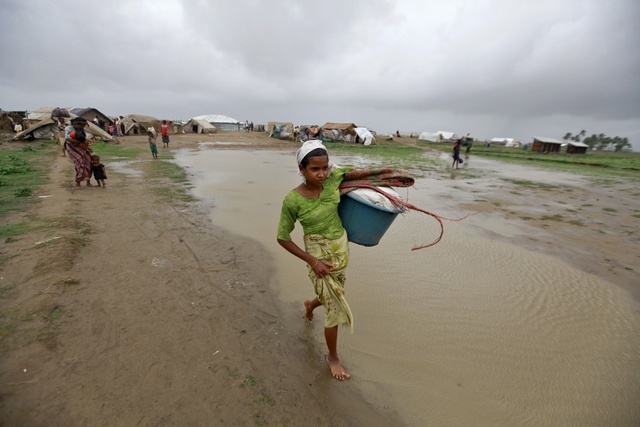Thousands of displaced Rohingya are still stranded in low-lying areas next to the sea, less than a day before a tropical storm is expected to batter northwestern Burma, local sources have warned.
Among these are hundreds of families, who are too terrified to leave their camps with state security forces, because they have previously been implicated in carrying out mass atrocities against the Muslim minority.
“The police get off trucks with riot gear and people are very afraid,” an aid worker told DVB from Ohn Daw or Coconut garden, one of the most vulnerable camps housing some 4,000 Rohingyas near Sittwe, on Wednesday night. “We’ve been in the communities when the police come and people start crying.”
“We’ve tried to convince them that the storm is coming and they may not survive, but they say they will take their chances. They are less afraid of the storm than they are the authorities.”
The UN has admitted that “there are still pockets of resistance”, but insists that local authorities and international aid groups are working around the clock to relocate as many people as possible, before Cyclone Mahasen is projected to hit land in southern Bangladesh on Friday morning.
It follows news that the president’s spokesperson, Ye Htut, threatened legal action against anyone who refuses to move. “The government will punish those who don’t follow our instructions to evacuate,” he told a press conference in Rangoon on Wednesday.
But human rights activists have described his threats as “absolutely disgraceful” and accused him of “tarnishing the efforts of others in the Burma government who are actually trying to help the IDPs [internally displaced persons] in Arakan state.”
“It’s completely understandable that some Rohingya are nervous about moving to an unknown destination with security forces, who just seven months ago were involved in committing crimes against humanity and ethnic cleansing against them,” Phil Robertson, deputy-Asia director of Human Rights Watch (HRW) told DVB on Thursday.
The UN says that local authorities have been “very flexible” in the relocation process and repeatedly assured locals that they will be able to return to their camps after the storm, providing they have not been swept away. Reports suggest that many IDPs, who refused to relocate to a military compound in Sittwe, were able to negotiate alternative locations in nearby schools and madrasas.
But aid workers say that poor information sharing has also fuelled distrust and resistance among the Rohingya, who are often left uncertain of the locations to which they are being resettled.
In southern Maungdaw township, near the Bangladeshi border, where the cyclone is expected to have the greatest impact, a local activist told DVB that displaced Rohingya have been the last to be moved – after border security (NaSaKa) camps and Arakanese villages — and often given no information whatsoever. As a result, only Rohingyas with relatives based further inland have been willing to accompany the NaSaKa in their trucks.
The UN admits that evacuations in Maungdaw, which has a majority Rohingya population, are “proceeding more slowly than in other locations” with only 64 families prepared for resettlement. According to Chris Lewa from the Arakan Project, the differences between cyclone preparations in Bangladesh and Burma were “striking”.
“They have sent teams of volunteers all over the district and gone along the beach to share their evacuation plans in area, where they expect waves six feet high,” she said, referring to Cox’s Bazar in southern Bangladesh, which hosts up to 250,000 Rohingya refugees from Burma.
But reportedly large-scale “spontaneous” movements of displaced Rohingya were initiated in southern Maungdaw on Wednesday night, after the Bangladeshi authorities raised the severity level of the cyclone.
It follows news that a group of more than 100 displaced Rohingya from Pauktaw, east of Sittwe, went missing after a botched attempt to flee the cyclone in a convoy of boats on Monday night.
But DVB’s local source in Sittwe said it was unlikely that anyone from Ohn Daw camp would leave before the storm – with or without state assistance.
“We’ve actually given up – we’ve tried everything we can possibly think of,” he said. “My feeling is that they won’t leave. Some have even told us that they are praying to Allah for the storm to come over them because they are prepared to die.”
Activists are concerned that some state officials could use Cyclone Mahasen as an opportunity to further persecute the Muslim minority, which is denied citizenship and basic rights by the government. “Our fear is that [the Rohingya] are playing right into the government’s hands,” he said.
The storm warnings mirror those of 2008, when Cyclone Nargis struck Burma, causing the worst natural disaster in the country’s history and killing nearly 140,000 people. Two years later, Arakan state was struck by Cyclone Giri, a powerful tropical cyclone, which destroyed some 15,000 homes.



